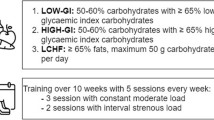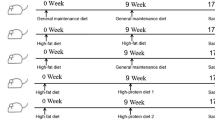Summary
The aim of this work was to find by which mechanisms an increased availability of plasma free fatty acids (FFA) reduced carbohydrate utilization during exercise. Rats were fed high-protein medium-chain triglycerides (MCT), high-protein long-chain triglycerides (LCT), carbohydrate (CHO) or high-protein low-fat (HP) diets for 5 weeks, and liver and muscle glycogen, gluconeogenesis and FFA oxidation were studied in rested and trained runner rats. In the rested state the hepatic glycogen store was decreased by fat and protein feeding, whereas soleus muscle glycogen concentration was only affected by high-protein diets. The percentage decrease in liver and muscle glycogen stores, after running, was similar in fat-fed, high-protein and CHO-fed rats. The fact that plasma glucose did not drastically change during exercise could be explained by a stimulation of hepatic gluconeogenesis: the activity of phosphoenolpyruvate carboxykinase (PEPCK) and liver phosphoenolpyruvate (PEP) concentration increased as well as cyclic adenosine monophosphate (AMPc) while liver fructose 2,6-bisphosphate decreased and plasma FFA rose. In contrast, the stimulation of gluconeogenesis in rested HP-, MCT- and LCT-fed rats appears to be independent of cyclic AMP.
Similar content being viewed by others
References
Askew EW, Dohm GL, Huston RL (1975) Fatty acid and ketone body metabolism in the rat: response to diet and exercise. J Nutr 105:1422–1432
Bach AC, Babayan UK (1982) Medium-chain triglycerides: an update. Am J Clin Nutr 36:950–962
Bergmeyer HU (ed) (1974) Methods of enzymatic analysis. Academic Press, New York
Berry MN, Clark DG, Grivell AR, Wallace PG (1983) The calorigenic nature of hepatic ketogenesis: a explanation for the stimulation of respiration induced by fatty acid substrates. Eur J Biochem 131:205–214
Berry MN, Clark DG, Grivell AR, Wallace PG (1985) The contribution of hepatic metabolism to diet induced thermogenesis. Metabolism 34:141–147
Chang HC, Lane MD (1966) The enzymatic carboxylation of phosphoenolpyruvate. J Biol Chem 241:2313–2420
Crozier G, Bois-Joyeux B, Chanez M, Girard J, Peret J (1987) Metabolic effects induced by long term feeding of medium-chain triglycerides in the rat. Metabolism 36:807–814
Dohm GL, Newsholme EA (1983) Metabolic control of hepatic gluconeogenesis during exercise. Biochem J 212:633–639
Dohm GL, Kasperec J, Barakat HA (1985) Time course of changes in gluconeogenic enzyme activities during exercise and recovery. Am J Physiol 249:E6-E11
Eisenstein AB, Strack I, Steiner A (1974) Increased hepatic gluconeogenesis without a rise of glucagon secretion in rats fed a high fat diet. Diabetes 23:869–875
Freedland RA, Krebs HA (1967) The effect of thyroxine treatment on the rate of gluconeogenesis in the perfused rat liver. Proc Biochem Soc 104:45
Friedman B, Goodman EW, Weinhouse S (1967) Effects of fatty acids on gluconeogenesis in the rat. J Biol Chem 242:3620–3627
Galbo H (1983) Hormonal and metabolic adaptation to exercise. Thieme, Stuttgart, pp 1–112
Galbo H, Hummier L, Petersen IB, Christensen NJ, Bie N (1977) Thyroid and testicular hormone responses to graded and prolonged exercise in man. Eur J Appl Physiol 36:101–106
Hers HG, Hue L (1983) Gluconeogenesis and related aspects of glycolysis. Annu Rev Biochem 52:617–653
Hickson RC, Rennie MJ, Conlee RK, Winder WW, Holloszy JO (1977) Effects of increased plasma fatty acids on glycogen utilization and endurance. J Appl Physiol 43:829–833
Huang MT, Lardy HA (1981) Effects of thyroid states on the Cori cycle, glucose-alanine cycle, and futile cycling of glucose metabolism in rats. Arch Biochem Biophys 209:41–51
Johannessen A, Hagen C, Galbo H (1981) PRL, TSH, T3 and T4 responses to exercise after fat and carbohydrate enriched diet. J Clin Endocrinol Metab 52:56–61
Krebs HA (1963) The Croonian Lecture. Gluconeogenesis. Proc R Soc Lond 159B:545–563
Loose DS, Cameron SK, Short H (1985) Thyroid hormone regulates transcription of the gene for cytosolic phosphoenolpyruvate carboxykinase (GTP) in rat liver. Biochemistry 24:4509–4512
Lowry OH, Rosebrough NJ, Farr AL, Randall RJ (1951) Protein measurement with the folin phenol reagent. J Biol Chem 193:265–275
Menahan LA, Wieland O (1969) The role of thyroid function in the metabolism of perfused rat liver with particular reference to gluconeogenesis. Eur J Biochem 10:188–194
Miller WC, Bryce GR, Conlee RH (1984) Adaptations to a high-fat diet that increase exercise endurance in male rats. J Appl Physiol: Respir Environ Exerc Physiol 56:78–83
Randle PJ, Newsholm EA, Garland PB (1964) Regulation of glucose uptake by muscle. 8. Effects of fatty acids, ketone bodies and pyruvate, and of alloxan diabetes and starvation, on the uptake and metabolic fate of glucose in rat heart and diaphragm muscles. Biochem J 93:652–665
Rennie MS, Winder WW, Holloszy JO (1976) A sparing effect of increased plasma fatty acids on muscle and liver glycogen content in the exercising rat. Biochem J 156:647–655
Roehring KL, Allred JB (1974) Direct enzymatic procedure for the determination of liver glycogen. Anal Biochem J 156:647–655
Shimizu S, Tani Y, Yamada H, Tabara M, Murachi T (1980) Enzymatic determination of serum free fatty acid. A colorimetric method. Anal Biochem 107:193–198
Snedecor GW, Cochran WG (1980) Statistical methods, 7th edn. Iowa, State University Press, Ames, Iowa, US
Tiedgen M, Seitz HJ (1980) Dietary control of circadian variations in serum insulin, glucagon and hepatic cyclic AMP. J Nutr 110:876–882
Tilghman SM, Hanson RW, Ballard FJ (1976) Hormonal regulation of phosphoenolpyruvate carboxykinase (GTP) in mammalian tissues. In: Hanson RW, Mehlman MA (eds) Gluconeogenesis: its regulation in mammalian species. Wiley, New York, pp 47–91
Van Schaftingen E, Lederer B, Bartrons R, Hers GH (1982) A kinetic study of pyrophosphate: fructose-6-phosphate phosphotransferase from potato tuber. Application to a microassay of fructose 2,6-bisphosphate. Eur J Biochem 129:191–195
Wahren J (1979) Metabolic adaptation to physical exercise in man. In: De Groot (ed) Endocrinology. Grune and Stratton, New York, pp 1911–1926
Wiley JH, Leveille GA (1973) Metabolic consequence of dietary medium chain triglycerides in the rat. J Nutr 103:829–835
Winder WW, Boullier J, Fell RD (1979) Liver glycogenolysis during exercise without a significant increase in cAMP. Am J Physiol 237:R147-R152
Author information
Authors and Affiliations
Rights and permissions
About this article
Cite this article
Satabin, P., Bois-Joyeux, B., Chanez, M. et al. Effects of long-term feeding of high-protein or high-fat diets on the response to exercise in the rat. Europ. J. Appl. Physiol. 58, 583–590 (1989). https://doi.org/10.1007/BF00418503
Accepted:
Issue Date:
DOI: https://doi.org/10.1007/BF00418503




